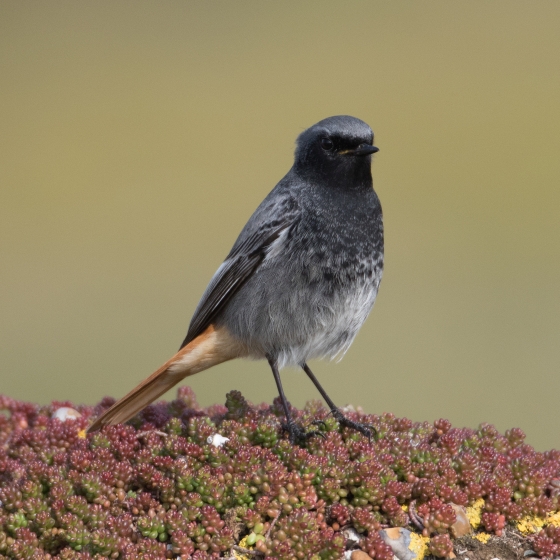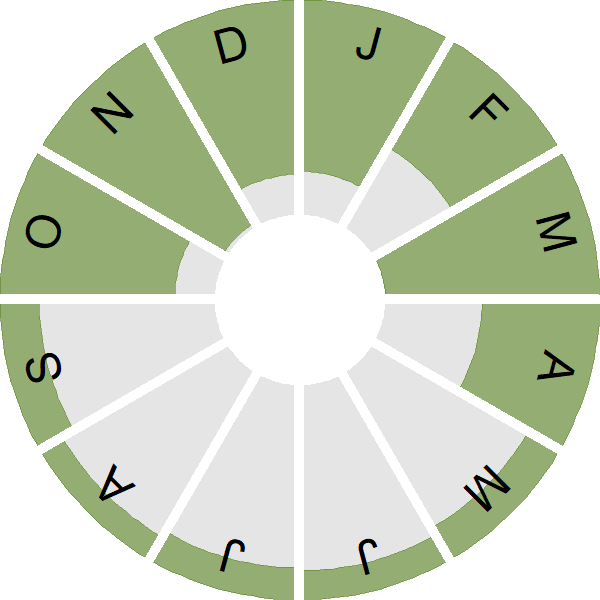Black Redstart

Introduction
Black Redstart is a scarce breeding bird in Britain, with a population thought to have peaked at 120 pairs and largely associated with industrial sites and city centres.
The species is regularly recorded at coastal sites in small numbers, and some individuals may overwinter. Black and Common Redstarts may occasionally hybridise.

Key Stats
Identification
ID Videos
This section features BTO training videos headlining this species, or featuring it as a potential confusion species.
Redstarts
Songs and Calls
Song:
Call:
Status and Trends
Conservation Status
Population Change
The Black Redstart is unusual amongst rare British breeding birds in that it is often found breeding in urban areas. The first breeding records occurred in the 1920s and, whilst it remained scarce, the number of records increased during the Second World War (Witherby & Fitter 1947; Fitter 1948), in particular in London which still remains one of its strongholds. A national survey in 1977 found a total of 104 territorial males, consistent with numbers obtained from local bird reports in the years immediately preceding and following the survey (Morgan & Glue 1981). The species remains scarce and is assessed by the Rare Breeding Birds Panel. The data suggest breeding numbers may have decreased since the late 1970s although numbers have remained stable in the 25 years to 2019 and there was a mean of 65 breeding pairs reported to the RBBP over the period 2015–2019 (including possible breeding records such as singing males) (Eaton et al. 2021). However, it is unclear whether a genuine decline has occurred given the difficulty in recording breeding evidence in urban areas. The number of 10-km squares with breeding evidence doubled between the 1968–72 and the 2008–11 Atlases with some gains occurring outside the core areas in south-east England (Balmer et al. 2013).
Distribution
Black Redstarts are localised breeders with most records concentrated around London, coastal Kent, East Anglia and northwest England. During 2008–11 there were no confirmed breeding records in Ireland and the only one in Scotland, on Lewis, involved the sighting of a single recently fledged juvenile, with the exact breeding site not determined. They are scarce in winter, with most records coming from along the south coasts of Ireland, Wales and England.
Occupied 10-km squares in UK
or view it on Bird Atlas Mapstore.
or view it on Bird Atlas Mapstore.
European Distribution Map
Distribution Change
Although the core breeding range has changed relatively little, the number of occupied squares with breeding evidence has doubled since 1968–72 and many of the gains were outside southeast England, suggesting a slow range expansion.
Change in occupied 10-km squares in the UK
or view it on Bird Atlas Mapstore.
or view it on Bird Atlas Mapstore.
Seasonality
Black Redstart can be recorded throughout the year; it is scarcest in the summer when a rare breeder. Most records are during autumn passage in late autumn and some birds winter, especially in the south.
Weekly pattern of occurrence
The graph shows when the species is present in the UK, with taller bars indicating a higher likelihood of encountering the species in appropriate regions and habitats.

Movement
Britain & Ireland movement
Foreign locations of birds ringed or recovered in Britain & Ireland
Dots show the foreign destinations of birds ringed in Britain & Ireland, and the origins of birds ringed overseas that were subsequently recaptured, resighted or found dead in Britain & Ireland. Dot colours indicate the time of year that the species was present at the location.
- Winter (Nov-Feb)
- Spring (Mar-Apr)
- Summer (May-Jul)
- Autumn (Aug-Oct)

European movements
EuroBirdPortal uses birdwatcher's records, such as those logged in BirdTrack to map the flows of birds as they arrive and depart Europe. See maps for this species here.
The Eurasian-African Migration Atlas shows movements of individual birds ringed or recovered in Europe. See maps for this species here.
Biology
Productivity and Nesting
Nesting timing
Egg measurements
Clutch Size
Survival and Longevity
Survival is shown as the proportion of birds surviving from one year to the next and is derived from bird ringing data. It can also be used to estimate how long birds typically live.
View number ringed each year in the Online Ringing Report.
lifespan
Biometrics
Wing length and body weights are from live birds (source).
Wing length
Body weight
Ring Size
Classification, names and codes
Classification and Codes
- Order: Passeriformes
- Family: Muscicapidae
- Scientific name: Phoenicurus ochruros
- Authority: SG Gmelin, 1774
- BTO 2-letter code: BX
- BTO 5-letter code: BLARE
- Euring code number: 11210
Alternate species names
- Catalan: cotxa fumada
- Czech: rehek domácí
- Danish: Husrødstjert
- Dutch: Zwarte Roodstaart
- Estonian: must-lepalind
- Finnish: mustaleppälintu
- French: Rougequeue noir
- Gaelic: Earr-deargan-dubh
- German: Hausrotschwanz
- Hungarian: házi rozsdafarkú
- Icelandic: Húsaskotta
- Irish: Earrdheargán Dubh
- Italian: Codirosso spazzacamino
- Latvian: melnais erickinš
- Lithuanian: dumine raudonuodege
- Norwegian: Svartrødstjert
- Polish: kopciuszek (zwyczajny)
- Portuguese: rabirruivo
- Slovak: žltochvost domový
- Slovenian: šmarnica
- Spanish: Colirrojo tizón
- Swedish: svart rödstjärt
- Welsh: Tingoch Du
Research
Causes of Change and Solutions
Causes of change
The causes of changes in Black Redstart numbers are unclear and speculative but the colonisation of England followed an expansion of the European breeding range from the mid-nineteenth century onwards. Climate change has been suggested as a possible driver of this range expansion, and the colonisation of England has been attributed to the creation of suitable nest sites due to bombing, particularly in London, and the microclimate of the city (Morgan & Glue 1981). Recent apparent decreases have in turn been speculatively attributed to a reduction in the number of available nest sites following development, with the creation of 'green roofs' designed for Black Redstarts being proposed as a potential solution (Grant, date unknown).

